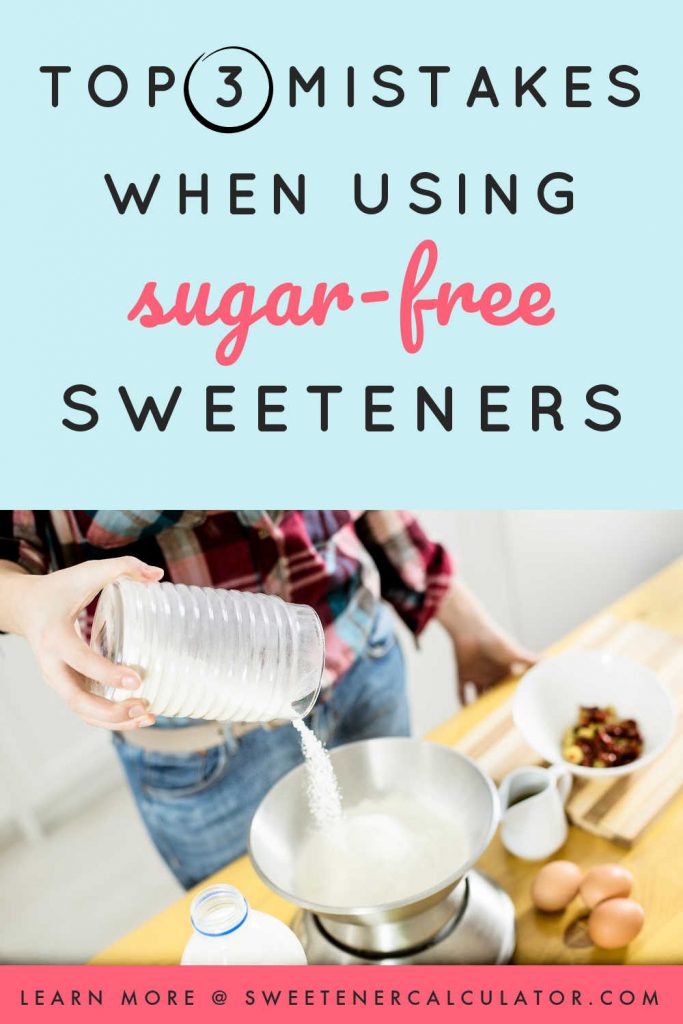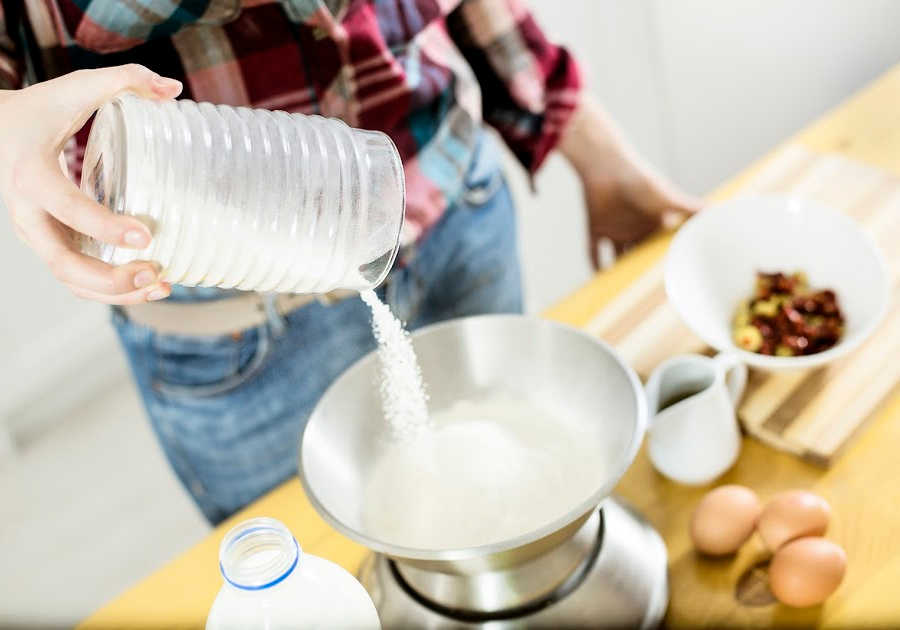Tired of having your low-carb, keto recipes flop? Check out these common mistakes you might be making when using sugar-free sweeteners. I’ll tell you how to fix them!
Does this sound familiar? You find this amazing recipe for a sugar-free dessert and check the sweetener on the list of ingredients — 16 to 20 drops of stevia. Upon searching on Amazon, to your amazement, twenty-five stevia drops products show up!
How are you supposed to know which sweetener is right?
Can you just buy any brand of stevia drops?
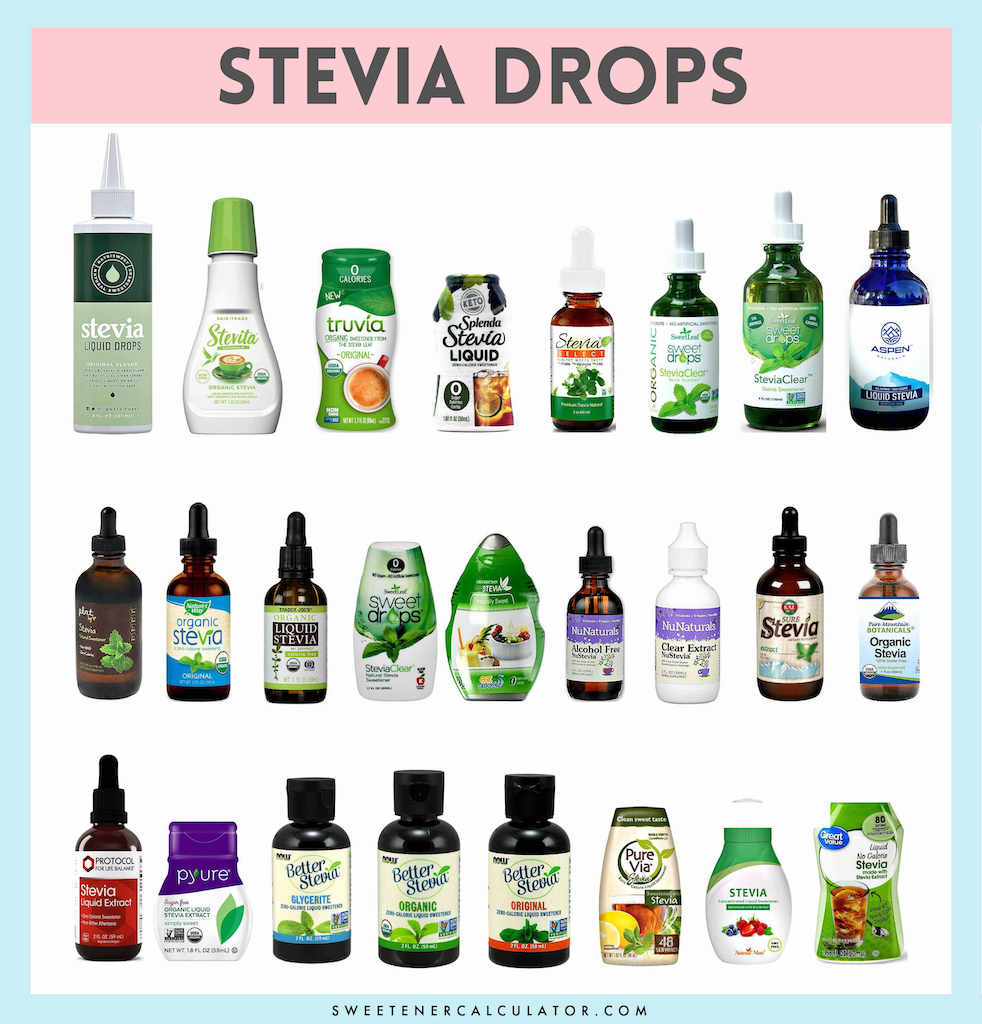
The simple answer is, well, no. The sweetness level will vary—16 to 20 drops might be equivalent to 1 ½ tsp of sugar with some brands but 3 tablespoons of sugar with others.
And if you had bought just any brand of stevia drops, your recipe would probably not go as planned. You measured too much and now you can taste all that licorice-like, metallic taste of stevia. Not good!
Confused and overwhelmed by all the sweeteners in stores?
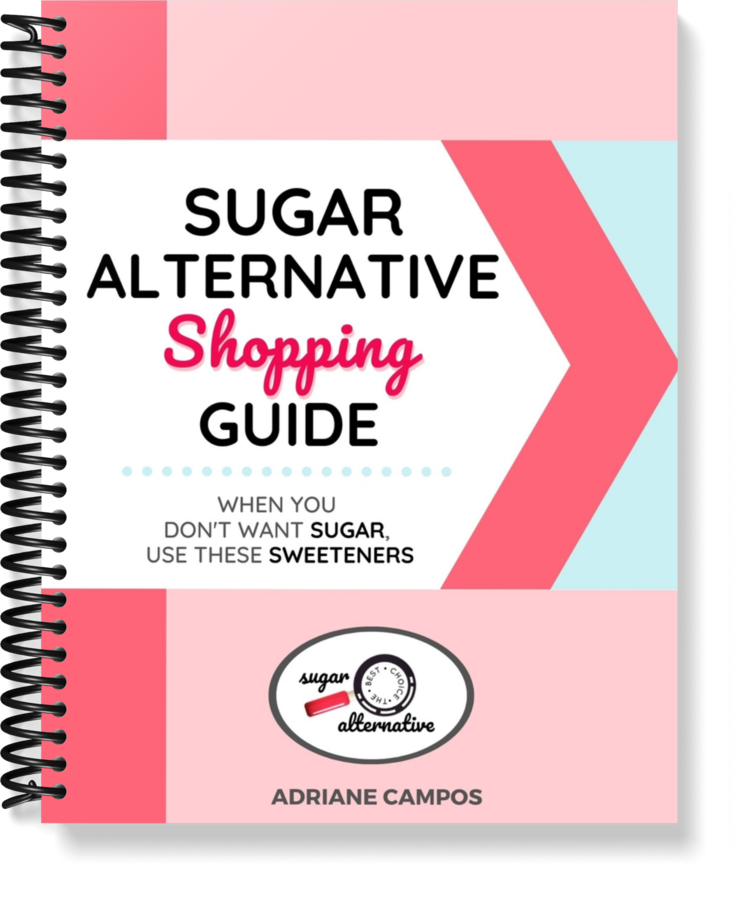 With 1000s of products sold in stores, our Sugar Alternative Shopping Guide will help you make sense of ALL the different options. It’s a goldmine—get it free for a limited time!
With 1000s of products sold in stores, our Sugar Alternative Shopping Guide will help you make sense of ALL the different options. It’s a goldmine—get it free for a limited time!
In this post, I’ll tell you the 3 most common mistakes we make when venturing into using sugar-free sweeteners and how to fix them.
For those saying they’ve never had anything turn out right when using sugar-free sweeteners, you don’t want to miss this out!
The Mistakes You’re Probably Making
When we start substituting one sweetener for another, we often have questions that don’t have a right answer, such as:
• How much stevia equals a cup of sugar?
The problem here is that stores sell 200+ stevia sweeteners. Some are as sweet as table sugar. Others are 2 to 100 times sweeter than sugar. So, my reply to this question is always which stevia are you talking about? Because stevia is not just ONE sweetener.
• What is the ratio of Truvía to sugar? How do I substitute Lakanto for Splenda?
The problem with those questions is that each of those brands—Truvía, Lakanto, Splenda—has a whole line of different products. They don’t always have the same sweetness level. I always reply to those questions asking the type of Truvía product they’re talking about? There isn’t just ONE Truvia product. Same with Lakanto and Splenda brands.
Those examples were just to give you a sense of some of the reasons sugar-free recipes flop.
I list below the 3 main mistakes we make when using sugar-free sweeteners:
Mistake #1: Not being specific about the product you have on hand
Let’s take stevia.
It’s one of the most popular sweeteners, and we have a whole lot of options, so I’ll dig deeper into the differences between stevia products sold in stores.
• Sweeteners have different ingredients
Stevia products are made up of 20 ingredient combinations. Even though their labels say simply “stevia sweetener,” they might be pure stevia leaf extract, or extracts dissolved in water, or even blends [those are the most common]. The image below shows how they compare based on the ingredients.
![Stevia products are made up of 20 ingredient combinations. Even though their labels say simply “stevia sweetener,” they might be pure stevia leaf extract, or extracts dissolved in water, or even blends [those are the most common].](https://sweetenercalculator.com/wp-content/uploads/what-is-stevia-made-out-of2-2-1024x946.jpeg)
The so-called “blends” contain stevia leaf extract combined with other ingredients—erythritol, maltodextrin, or sugars.
• Sweeteners are available in different forms
Stores sell liquid and dry stevia. Liquids are viscous (syrups) or not. Dry sweeteners come as granulated, powdered, or brown sugar replacements.
To use them, you might need to count drops, squeezes, teaspoons, tablespoons, cups, packets, sticks, cubes, or tablets.
• Sweeteners have different sweetness levels
You can’t just substitute 1 teaspoon (tsp) of sugar for 1 tsp of stevia.
Instead, sometimes you’ll need 1 packet, 4 drops, or 1/64 tsp of stevia, depending on the product you have on hand. Typically, you’d have to look for a “conversion chart” in the product’s package to find out how much to use. Conversion charts always compare the sweetness of the product to table sugar.
The problem is conversion charts are not always disclosed on the label. You might have to go to the product’s website, or contact the seller directly.
[I have an EASY solution for that later in this post. Spoiler: use my Sweetener Calculator].
You might wonder, when do I need a conversion chart?
1- If sweetener is as sweet as sugar, no conversion chart is needed
The so-called “1:1 or cup-for-cup sugar replacement” are easy to measure. Spoon for spoon, they are as sweet as table sugar. If your recipe calls for a half cup of sugar, you simply replace it with half a cup of the sweetener. Easy!
2- If sweetener is sweeter or less sweet than sugar, look for a chart
Some sweeteners are 2 times sweeter than sugar—aka 2:1 sugar replacement (2 tsp of sugar are as sweet as 1 tsp of sweetener). Others are half as sweet as sugar. Stevia drops, referred to at the beginning of this post, are up to 16x sweeter than sugar, and pure extracts are 64 to 96x.
To help you find out the sweetness level of each sweetener [and NOT have to chase for a conversion chart], I’ve assembled the Sweetener Calculator. I’ll tell you how to use it in a little bit.
The bottom line: The first mistake is assuming all stevia sweeteners have the same sweetness level. So, to avoid it, just keep in mind that each zero-calorie sweetener—be it monk fruit, allulose, or sucralose—comes in a variety of ingredients, forms, and sweetness level.
Stevia is not just one sweetener. And that is the same with all sugar-free sweeteners:
– If you’re thinking, “What is the ratio of monk fruit to sugar?”, be aware that stores sell 100+ monk fruit products.
– Wondering “How do I substitute allulose for sugar? Just know there are 40 allulose sweeteners in store shelves.
– Looking for “How much erythritol is equal to sugar?” I’ll tell you I’ve found over 180 erythritol sweeteners.
Mistake #2: Calling a sweetener by the brand name and not being specific about the type
To help you understand the 2nd most common mistake, I’ll give you 3 questions I get ALL. THE. TIME.
• How do I substitute Lakanto for sugar?
Usually the mistake starts like that. You want to try this keto recipe made with Lakanto, so you buy it, and when you start mixing ingredients, you noticed the recipe actually calls for Lakanto pure extract, which is not the same Lakanto you bought—the so-called Classic. You go ahead and make it anyway, and sure enough, your recipe did not go well.
Ugh!
The thing is Lakanto, a brand of monk fruit, sells a whole line of sweeteners:
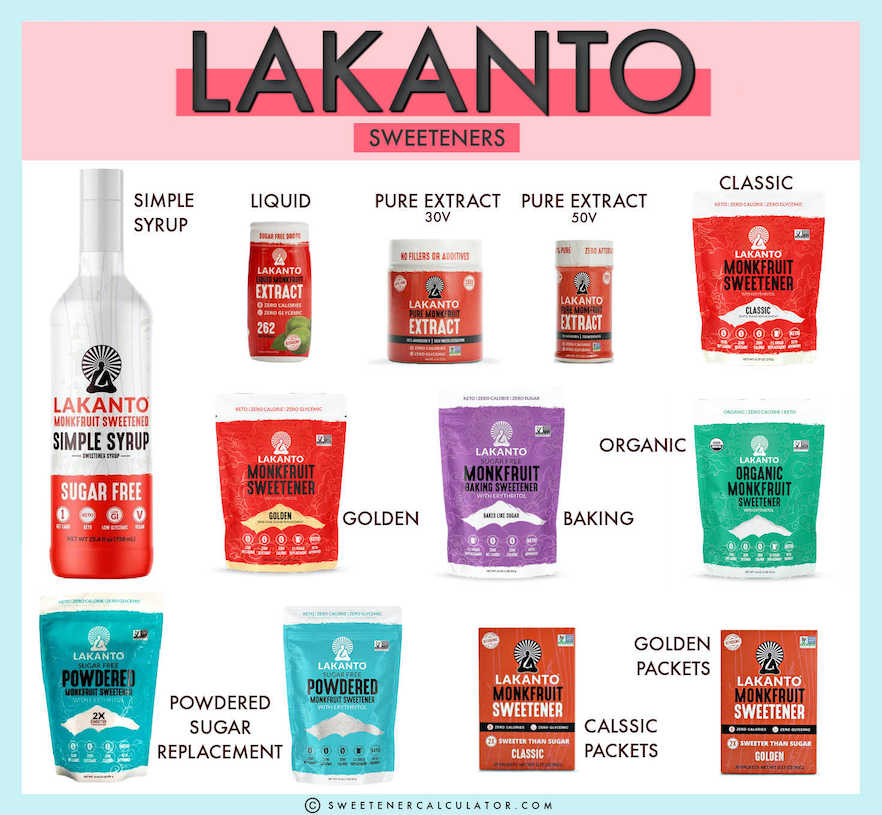
Lakanto Classic
Lakanto Organic
Lakanto Golden
Lakanto Powdered
Lakanto Baking
Lakanto Pure Extract
Lakanto Extract Drops
Lakanto Simple Syrup
Lakanto Golden Packets
Lakanto Classic Packets
They don’t always have the same sweetness level. If you want to find out how to use Lakanto, you need to know what type of product.
That’s why the question “How much Lakanto equals one teaspoon of sugar? is not easy to answer.
If it’s the Lakanto Classic, one tsp is as sweet as one tsp of table sugar. With Lakanto Drops, it’s 2 to 4 drops. For Lakanto Pure Extract, you’ll need 1/64 of a tsp.
Another common question I get is regarding the Truvía brand.
• How do I convert Truvía to sugar?
If you are thinking, “How much Truvía sweetener do I substitute for sugar?”
Here is what you need to know.
Truvía, a brand of stevia, is made up of a variety of products with different ingredients and sweetness levels:
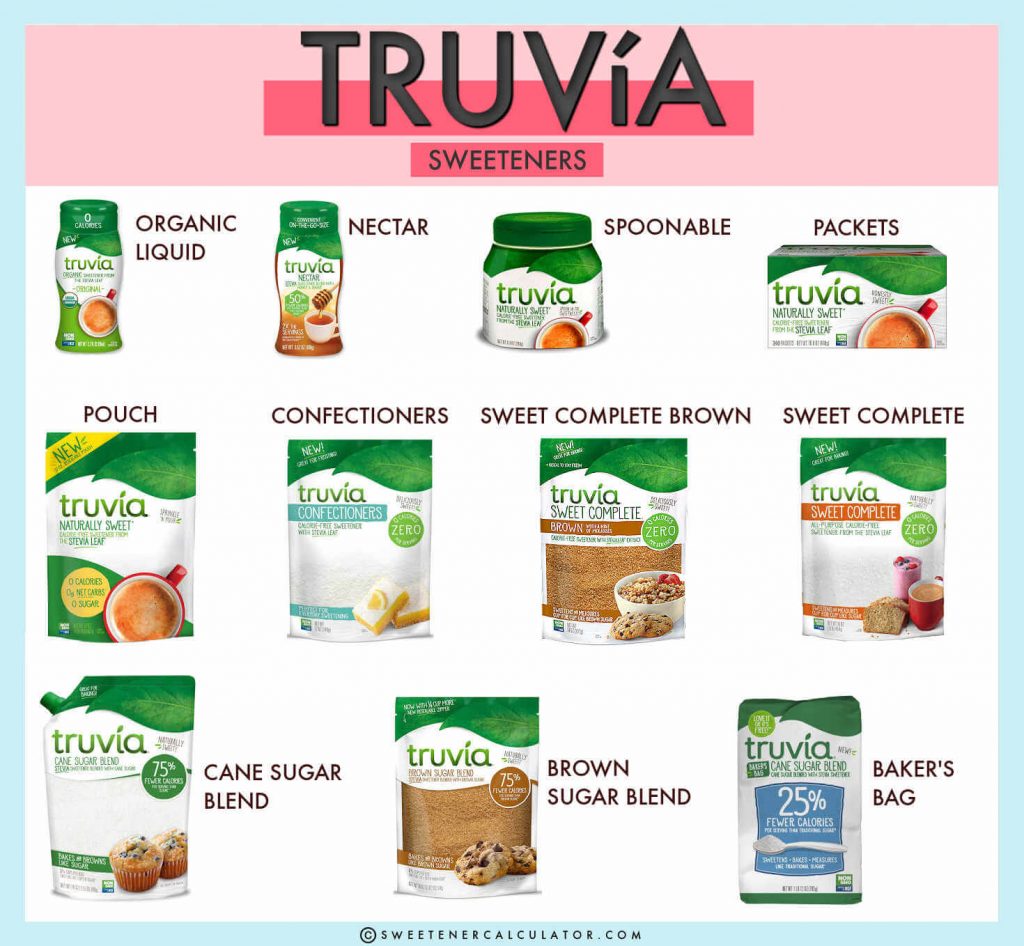
Truvía Organic Liquid
Truvía Nectar
Truvía Packets
Truvía Sticks
Truvía Spoonable
Truvía Resealable Pouch
Truvía Sweet Complete
Truvía Sweet Complete Brown
Truvía Confectioners
Truvía Cane Sugar Blend
Truvía Brown Sugar Blend
Truvía Baker’s Bag
Their sweetness level varies. To substitute one tsp of sugar, you might need to measure 1/8 of a tsp of Truvía Organic Liquid, 3/8 tsp of Truvía Spoonable, or 1 tsp of Truvía Sweet Complete.
Also, some of those products are not even sugar-free, such as Truvía Cane Sugar Blend, Brown Sugar Blend, and Baker’s Bag.
Now, I hope you understand why the question “What’s the ratio of Truvía to sugar?” doesn’t have a right answer.
• What is the ratio of Splenda to sugar?
If you wonder, “How much Splenda sweetener do I substitute for sugar?
The Splenda brand includes over 10 products, not just the well-known yellow packets made up of Sucralose.
Splenda sells 5 lines of products: the original, liquid, stevia, monk fruit, and more recently, allulose.
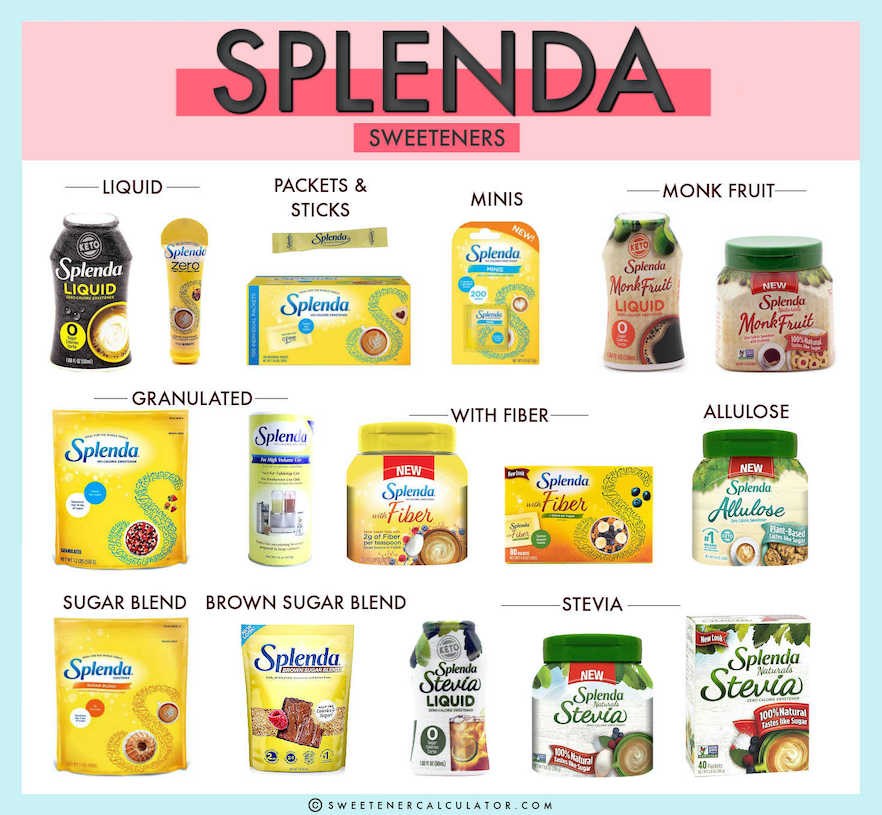
Splenda Individual Packets
Splenda Minis
Splenda Granulated
Splenda for High Volume Use
Splenda Liquid
Splenda 1 Gram of Fiber Packets
Splenda with Fiber Jar
Splenda Sugar Blend
Splenda Brown Sugar Blend
Splenda Stevia
Splenda Stevia Liquid
Splenda Stevia Packets
Splenda Monk Fruit
Splenda Monk Fruit Liquid
Splenda Allulose
Their sweetness level is not always the same. To substitute one tsp of sugar, you might need to measure squeezes (½ squeeze for Splenda Stevia Liquid but 1 for Splenda Liquid) or teaspoons (1 tsp for Splenda Monk Fruit but 2 tsp for Splenda Stevia).
The bottom line: The 2nd mistake is not reading the product’s type on the label and simply calling it by the brand name. To avoid the second mistake, be aware that one brand sometimes has a bunch of products with different sweetness levels.
Mistake #3: Calculating the wrong amount to use
This is so important that I wrote a whole post about it.
I know it would be much easier if all sweeteners were a 1:1 sugar replacement, but they aren’t. You might have to add less or more than sugar.
That’s the 3rd most common mistake. It’s not calculating the right amount to use. We add too much or too little, and the recipes turn out wayyy too sweet or not sweet enough.
I’ll give you an example.
Imagine that upon reading the product’s label, you find that 3/8 tsp of the sugar-free sweetener equals to 1 tsp of table sugar. Because your recipe calls for one and a half cups of sugar, you’ll have to calculate it yourself. And if you’re not particurlary good at math, it’s easy to make a mistake and end up measuring the wrong amount of sweetener.
I get it! It’s HARD.
That’s why I created a calculator to help you measure the right amount of sweeteners in your drinks, baking, and cooking.
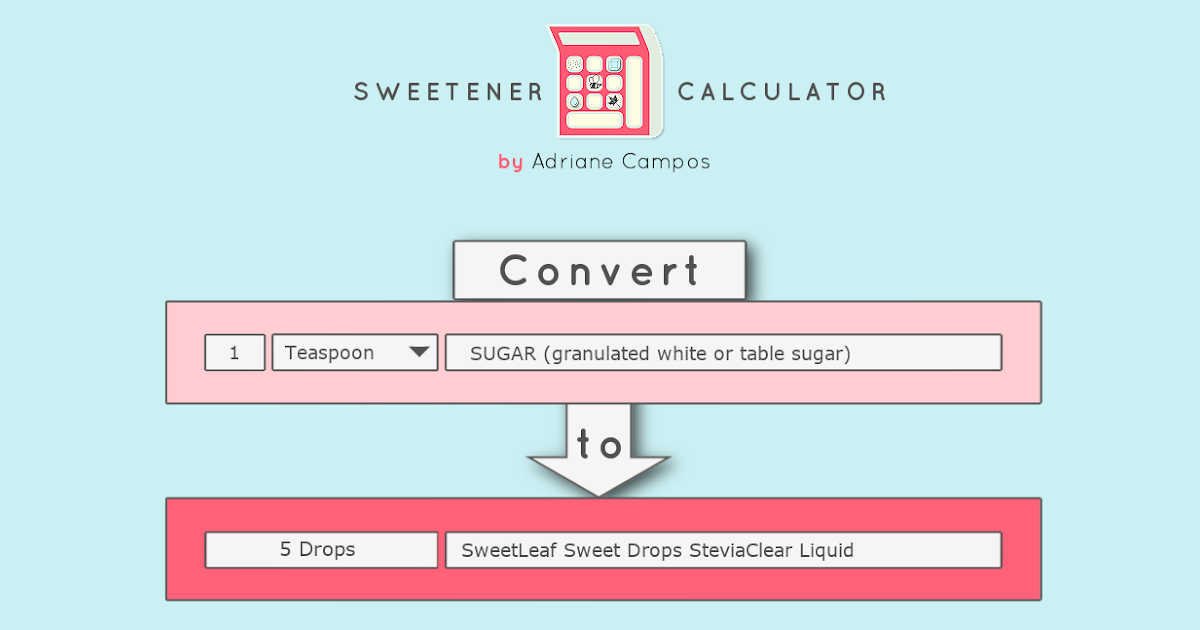
The bottom line: The third mistake is not calculating the right amount to use. Use my Sweetener Calculator to avoid that.
3 Steps to Avoid Sugar-free Recipe Flop
Here’s what you have to do to prevent the 3 top mistakes when using sugar-free sweeteners.
Start by looking at the label and then follow 3 easy steps:
- What’s the brand? (Lakanto, Truvía, Splenda?)
- What’s the type of the product? (Lakanto Liquid, Truvía Nectar, Splenda Granulated?)
- Enter exactly that in the Sweetener Calculator to find the right amount to use.
If you want to learn all the details on how to use the Sweetener Calculator, read a previous post titled Here is a Quick Way to Convert Between 1000s of Sweeteners.
Use the result you get from the calculator as a guide. You can fine-tune the taste by reading my 6 Tips to Convert Sweeteners Right. That way you avoid recipes that turn out too sweet or not sweet enough.
As an example, let’s say you have a monk fruit sweetener.
The brand is NOW BetterStevia. The type is “Organic Liquid Sweetener.” Look for exactly that on the Sweetener Calculator. To substitute 2 tablespoons of table sugar, the calculator tells you to use 24 drops. That’s it! You can now substitute the right amount.
Summary
To recap, here are the 3 mistakes you might be making when using sugar-free-sweeteners:
1- Not being specific about the product you have on hand
2- Calling a sweetener by the brand name and not being specific about the type
3- Calculating the wrong amount
Each sugar-free sweetener (stevia, monk fruit, erythritol, allulose, sucralose) comes in a variety of forms, brands, and ingredients. They offer different sweetness levels. You might need to measure 1 packet, 4 drops, or 1/64 tsp of stevia to substitute 1 teaspoon of sugar. Oftentimes, we get confused and end up measuring the wrong amount.
Conclusion
You can avoid common mistakes when using sugar-free sweeteners. Start by reading the product’s label. Get the brand name, the type, and then enter exactly that on the Sweetener Calculator.
